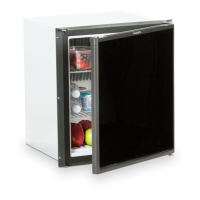21
Service and maintenance ( for Service Technician only )
The user should be aware of service that must be done on a regular schedule
to keep the refrigerator operating properly. The service should only be per-
formed by a qualified technician who is familiar with LP gas systems and
refrigerators.
REFRIGERATOR REMOVAL
Before working on, or removing the refrigerator, make sure the electrical supply (AC
and DC) is turned OFF before leads are disconnected. Shut off the gas supply.
Disconnect and cap the gas supply line. Loosen the screws anchoring the refrigera
tor to the enclosure and slide the refrigerator out of the compartment.
Replacement is the reverse of removal. Check all connections for gas leaks.
PERIODIC MAINTENANCE
To keep a Dometic refrigerator operating efficiently and safely, periodic inspection and
cleaning of several components once or twice a year is recommended.
A.It is important to keep the area at the back of the refrigerator clean. Check the l
ower vent,,upper vent and area between these openings for any obstructions such as
bird/insect nests, spider webs, etc. Clean the coils on the back of the refrigerator. Use
a soft brist led brush to dust off the coils..
NOTE: AVOID SPRAYING WATER THROUGH THE REFRIGERATOR VENTS WHEN
WASHING THE RV.
It is important to keep the refrigerator vent area free from combustible material, gaso
line and other flammable vapors or liquids.
B. Check all connections in the LP gas system (at the back of the refrigerator) for gas
leaks. The LP gas supply must be turned on. Apply a noncorrosive bubble solution to
all LP gas connections. The appearance of bubbles indicates a leak and should be
repaired immediately by a qualified serviceman who is familiar with LP gas
systems and refrigerators.
C. Examination and Cleaning of Flue, Burner and Jet
Once or twice a year, look through the opening (see FIG. 9) in the burner box and
examine the appearance of the burner flame which should be predominantly blue in
color when the gas thermostat knob is set to its highest position. (Refer to FIG. 10).
If this is not the case, clean the flue, burner, jet, etc.
! WARNING
DO NOT USE A FLAME TO CHECK FOR GAS LEAKS.
6.7

